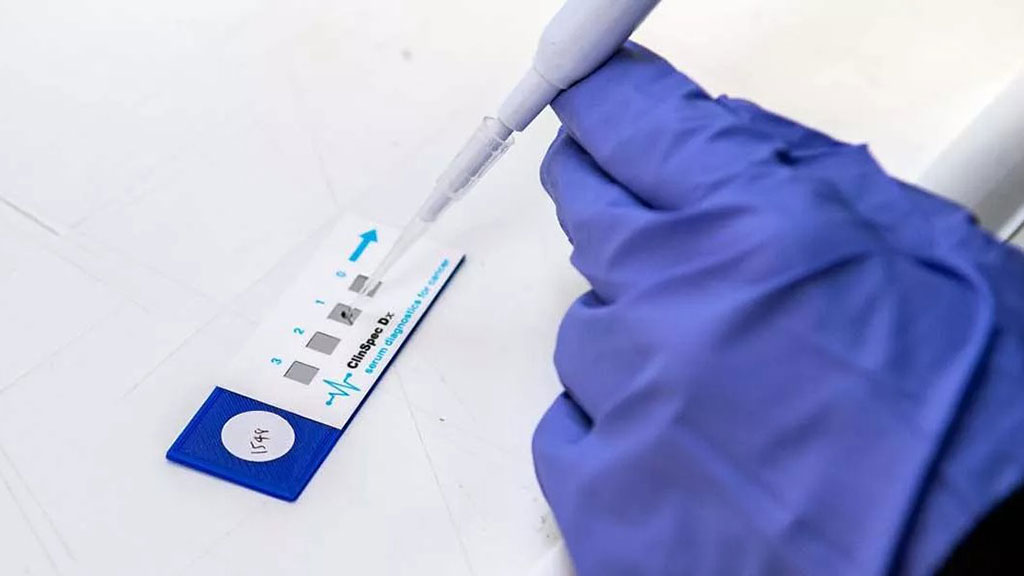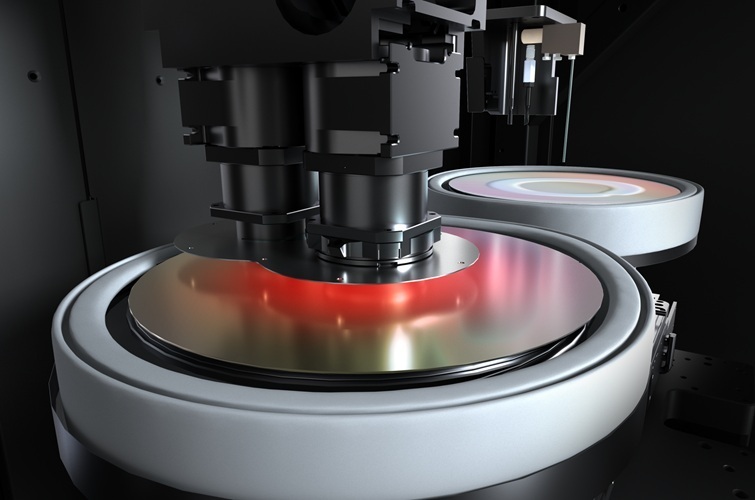A Novel Liquid Biopsy Spectroscopy Method for Early Detection of Brain Tumors
|
By LabMedica International staff writers Posted on 16 Aug 2021 |

Image: Highly effective early diagnostic tests could revolutionize cancer detection. Here, a sample is dropped onto a disposable Dxcover Slide and dried for analysis (Photo courtesy of Dxcover Limited)
A blood-based liquid biopsy approach enables detection of brain tumors that are so small and low-grade that the patient will often have few or no symptoms.
Due to the non-specific symptoms of brain cancer, gliomas will often remain undetected until they are larger or at a higher grade, reducing the patient’s likelihood of a good clinical outcome. Earlier detection and diagnosis of brain tumors is vital to improve patient outcomes, leading to safer surgeries and earlier treatments.
In this regard, investigators at the University of Strathclyde (Glasgow, United Kingdom) and the biotech company Dxcover Limited (Glasgow, United Kingdom) developed a Multi Cancer Early Detection (MCED) Platform based on a spectroscopic liquid biopsy approach for detection of small and low-grade gliomas.
This approach combined attenuated total reflection (ATR)-Fourier transform infrared (FTIR) spectroscopy coupled with supervised learning methods and machine learning algorithms for the analysis of dried blood samples.
The current study was carried out on a cohort of 177 patients (90 patients with high-grade glioma (glioblastoma (GBM) or anaplastic astrocytoma), or low-grade glioma (astrocytoma, oligoastrocytoma, and oligodendroglioma). Tumor volumes were calculated from magnetic resonance imaging (MRI) investigations and patients were split into two groups depending on MRI parameters. Combining the spectroscopy technology with supervised learning methods and machine learning algorithms, 90 tumor patients were stratified against 87 control patients who displayed no symptomatic indications of cancer, and were classified as either glioma or non-glioma.
Results revealed that sensitivities, specificities, and balanced accuracies were all greater than 88%, the area under the curve (AUC) was 0.98, and cancer patients with tumor volumes as small as 0.2 cubic centimeters were correctly identified.
Senior author Dr. Matthew Baker, chief technical officer of Dxcover Limited, said, "This breakthrough is a watershed moment in the development of early cancer detection. The study demonstrates the effectiveness of our Dxcover Brain Cancer Liquid Biopsy at detecting even the smallest brain tumors, which is great news for the care of future brain cancer patients, increasing treatment options and potentially extending life expectancy. Clinical tests like this are a crucial part of Dxcover's journey to develop and commercialize a widely accepted Multi-Cancer Early Detection platform to help save lives."
The liquid biopsy for early glioma detection was described in the July 30, 2021, online edition of the journal Cancers.
Related Links:
University of Strathclyde
Dxcover Limited
Due to the non-specific symptoms of brain cancer, gliomas will often remain undetected until they are larger or at a higher grade, reducing the patient’s likelihood of a good clinical outcome. Earlier detection and diagnosis of brain tumors is vital to improve patient outcomes, leading to safer surgeries and earlier treatments.
In this regard, investigators at the University of Strathclyde (Glasgow, United Kingdom) and the biotech company Dxcover Limited (Glasgow, United Kingdom) developed a Multi Cancer Early Detection (MCED) Platform based on a spectroscopic liquid biopsy approach for detection of small and low-grade gliomas.
This approach combined attenuated total reflection (ATR)-Fourier transform infrared (FTIR) spectroscopy coupled with supervised learning methods and machine learning algorithms for the analysis of dried blood samples.
The current study was carried out on a cohort of 177 patients (90 patients with high-grade glioma (glioblastoma (GBM) or anaplastic astrocytoma), or low-grade glioma (astrocytoma, oligoastrocytoma, and oligodendroglioma). Tumor volumes were calculated from magnetic resonance imaging (MRI) investigations and patients were split into two groups depending on MRI parameters. Combining the spectroscopy technology with supervised learning methods and machine learning algorithms, 90 tumor patients were stratified against 87 control patients who displayed no symptomatic indications of cancer, and were classified as either glioma or non-glioma.
Results revealed that sensitivities, specificities, and balanced accuracies were all greater than 88%, the area under the curve (AUC) was 0.98, and cancer patients with tumor volumes as small as 0.2 cubic centimeters were correctly identified.
Senior author Dr. Matthew Baker, chief technical officer of Dxcover Limited, said, "This breakthrough is a watershed moment in the development of early cancer detection. The study demonstrates the effectiveness of our Dxcover Brain Cancer Liquid Biopsy at detecting even the smallest brain tumors, which is great news for the care of future brain cancer patients, increasing treatment options and potentially extending life expectancy. Clinical tests like this are a crucial part of Dxcover's journey to develop and commercialize a widely accepted Multi-Cancer Early Detection platform to help save lives."
The liquid biopsy for early glioma detection was described in the July 30, 2021, online edition of the journal Cancers.
Related Links:
University of Strathclyde
Dxcover Limited
Latest Molecular Diagnostics News
- Blood Test Could Identify Patients at Risk for Severe Scleroderma
- Gene-Based Blood Test Accurately Predicts Tumor Recurrence of Advanced Skin Cancer
- Rapid Blood Test Identifies Pre-Symptomatic Patients with Parkinson’s Disease
- Blood Test for Early Alzheimer's Detection Achieves Over 90% Accuracy
- RNA-Based Blood Test Detects Preeclampsia Risk Months Before Symptoms
- First Of Its Kind Test Uses microRNAs to Predict Toxicity from Cancer Therapy
- Novel Cell-Based Assay Provides Sensitive and Specific Autoantibody Detection in Demyelination
- Novel Point-of-Care Technology Delivers Accurate HIV Results in Minutes
- Blood Test Rules Out Future Dementia Risk
- D-Dimer Testing Can Identify Patients at Higher Risk of Pulmonary Embolism
- New Biomarkers to Improve Early Detection and Monitoring of Kidney Injury
- Chemiluminescence Immunoassays Support Diagnosis of Alzheimer’s Disease
- Blood Test Identifies Multiple Biomarkers for Rapid Diagnosis of Spinal Cord Injury
- Highly Accurate Blood Test Diagnoses Alzheimer’s and Measures Dementia Progression
- Simple DNA PCR-Based Lab Test to Enable Personalized Treatment of Bacterial Vaginosis
- Rapid Diagnostic Test to Halt Mother-To-Child Hepatitis B Transmission
Channels
Clinical Chemistry
view channel
New Method Uses Pulsed Infrared Light to Find Cancer's 'Fingerprints' In Blood Plasma
Cancer diagnoses have traditionally relied on invasive or time-consuming procedures like tissue biopsies. Now, new research published in ACS Central Science introduces a method that utilizes pulsed infrared... Read more
Carbon Nanotubes Help Build Highly Accurate Sensors for Continuous Health Monitoring
Current sensors can measure various health indicators, such as blood glucose levels, in the body. However, there is a need to develop more accurate and sensitive sensor materials that can detect lower... Read moreHematology
view channel
New Scoring System Predicts Risk of Developing Cancer from Common Blood Disorder
Clonal cytopenia of undetermined significance (CCUS) is a blood disorder commonly found in older adults, characterized by mutations in blood cells and a low blood count, but without any obvious cause or... Read more
Non-Invasive Prenatal Test for Fetal RhD Status Demonstrates 100% Accuracy
In the United States, approximately 15% of pregnant individuals are RhD-negative. However, in about 40% of these cases, the fetus is also RhD-negative, making the administration of RhoGAM unnecessary.... Read moreImmunology
view channel
Stem Cell Test Predicts Treatment Outcome for Patients with Platinum-Resistant Ovarian Cancer
Epithelial ovarian cancer frequently responds to chemotherapy initially, but eventually, the tumor develops resistance to the therapy, leading to regrowth. This resistance is partially due to the activation... Read more
Machine Learning-Enabled Blood Test Predicts Immunotherapy Response in Lymphoma Patients
Chimeric antigen receptor (CAR) T-cell therapy has emerged as one of the most promising recent developments in the treatment of blood cancers. However, over half of non-Hodgkin lymphoma (NHL) patients... Read moreMicrobiology
view channel
Handheld Device Delivers Low-Cost TB Results in Less Than One Hour
Tuberculosis (TB) remains the deadliest infectious disease globally, affecting an estimated 10 million people annually. In 2021, about 4.2 million TB cases went undiagnosed or unreported, mainly due to... Read more
New AI-Based Method Improves Diagnosis of Drug-Resistant Infections
Drug-resistant infections, particularly those caused by deadly bacteria like tuberculosis and staphylococcus, are rapidly emerging as a global health emergency. These infections are more difficult to treat,... Read more
Breakthrough Diagnostic Technology Identifies Bacterial Infections with Almost 100% Accuracy within Three Hours
Rapid and precise identification of pathogenic microbes in patient samples is essential for the effective treatment of acute infectious diseases, such as sepsis. The fluorescence in situ hybridization... Read morePathology
view channel
New Error-Corrected Method to Help Detect Cancer from Blood Samples Alone
"Liquid biopsy" technology, which relies on blood tests for early cancer detection and monitoring cancer burden in patients, has the potential to transform cancer care. However, detecting the mutational... Read more
"Metal Detector" Algorithm Hunts Down Vulnerable Tumors
Scientists have developed an algorithm capable of functioning as a "metal detector" to identify vulnerable tumors, marking a significant advancement in personalized cancer treatment. This breakthrough... Read more
Novel Technique Uses ‘Sugar’ Signatures to Identify and Classify Pancreatic Cancer Cell Subtypes
Pancreatic cancer is often asymptomatic in its early stages, making it difficult to detect until it has progressed. Consequently, only 15% of pancreatic cancers are diagnosed early enough to allow for... Read moreTechnology
view channel
Pain-On-A-Chip Microfluidic Device Determines Types of Chronic Pain from Blood Samples
Chronic pain is a widespread condition that remains difficult to manage, and existing clinical methods for its treatment rely largely on self-reporting, which can be subjective and especially problematic... Read more
Innovative, Label-Free Ratiometric Fluorosensor Enables More Sensitive Viral RNA Detection
Viruses present a major global health risk, as demonstrated by recent pandemics, making early detection and identification essential for preventing new outbreaks. While traditional detection methods are... Read moreIndustry
view channel
Cepheid and Oxford Nanopore Technologies Partner on Advancing Automated Sequencing-Based Solutions
Cepheid (Sunnyvale, CA, USA), a leading molecular diagnostics company, and Oxford Nanopore Technologies (Oxford, UK), the company behind a new generation of sequencing-based molecular analysis technologies,... Read more
Grifols and Tecan’s IBL Collaborate on Advanced Biomarker Panels
Grifols (Barcelona, Spain), one of the world’s leading producers of plasma-derived medicines and innovative diagnostic solutions, is expanding its offer in clinical diagnostics through a strategic partnership... Read more






















